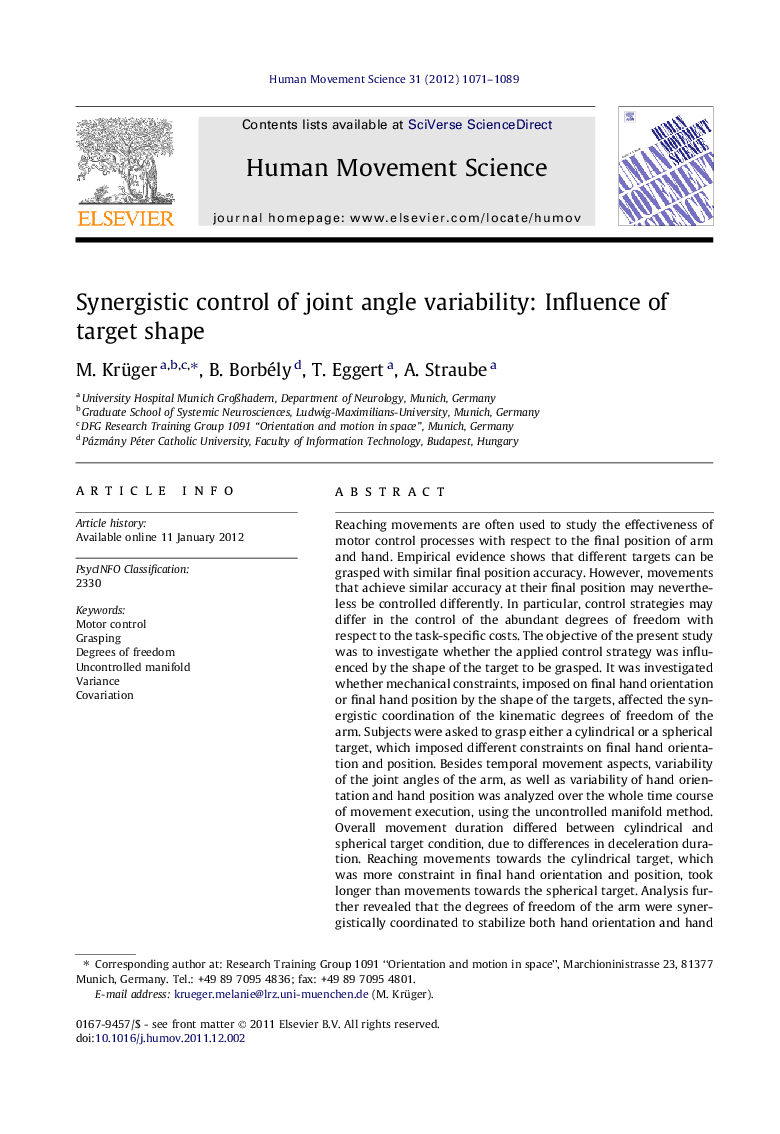| کد مقاله | کد نشریه | سال انتشار | مقاله انگلیسی | نسخه تمام متن |
|---|---|---|---|---|
| 928371 | 922362 | 2012 | 19 صفحه PDF | دانلود رایگان |

Reaching movements are often used to study the effectiveness of motor control processes with respect to the final position of arm and hand. Empirical evidence shows that different targets can be grasped with similar final position accuracy. However, movements that achieve similar accuracy at their final position may nevertheless be controlled differently. In particular, control strategies may differ in the control of the abundant degrees of freedom with respect to the task-specific costs. The objective of the present study was to investigate whether the applied control strategy was influenced by the shape of the target to be grasped. It was investigated whether mechanical constraints, imposed on final hand orientation or final hand position by the shape of the targets, affected the synergistic coordination of the kinematic degrees of freedom of the arm. Subjects were asked to grasp either a cylindrical or a spherical target, which imposed different constraints on final hand orientation and position. Besides temporal movement aspects, variability of the joint angles of the arm, as well as variability of hand orientation and hand position was analyzed over the whole time course of movement execution, using the uncontrolled manifold method. Overall movement duration differed between cylindrical and spherical target condition, due to differences in deceleration duration. Reaching movements towards the cylindrical target, which was more constraint in final hand orientation and position, took longer than movements towards the spherical target. Analysis further revealed that the degrees of freedom of the arm were synergistically coordinated to stabilize both hand orientation and hand position, when grasping either the spherical or the cylindrical target. This suggests that the applied control strategy in natural reaching movements can simultaneously account for multiple task constraints. The analysis further revealed that stabilization of hand orientation was stronger when reaching towards a cylindrical target, which imposed more constraints on final hand orientation. In contrast, hand position was more strongly stabilized in the spherical target shape condition, where stronger constraints on final hand position were applied. This suggests that different target shapes do influence the control strategy of reaching movements even though variability at movement end was not affected.
► The amount of end point variability is not influenced by the shape of the target to be grasped.
► The structure of joint angle variability is influenced by the shape of the target.
► The degrees of freedom of the arm are coordinated to stabilize important task variables.
► Stronger stabilization appears for the more constraint task variable.
► Target shape does influence the applied control strategy.
Journal: Human Movement Science - Volume 31, Issue 5, October 2012, Pages 1071–1089